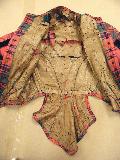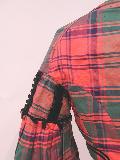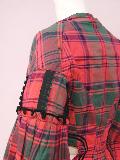This 1860s red, blue, and green plaid bodice is made from lightweight silk. It is trimmed with black cotton velvet ribbon. The lining throughout is brown glazed linen. Some seams on this garment have been machine stitched, but most of the bodice has been made and trimmed by hand.
Overview
The drop shoulder bodice is flatlined to brown linen. The front is shaped with two darts on each side of the center front opening. There is a second row of hand stitching on each dart indicating that there may have been bones in the channels at one time. There is a diagonal seam that runs from 1 1/2" behind the natural underarm seam position at the armhole to 3" behind at the waist. The seam allowances are double stitched and hold a bone. The side back seams are pressed to the side and overcast. The shoulder seam drops to the back 3". When buttoned, the front has two points, vest-style. It closes in front with 14 buttons; the buttonholes are hand stitched and are 1/2" wide. The neck and bottom edge are corded with 1/16" self-fabric. All corners are mitered. None of the darts have been cut upon.
The sleeve consists of a small jockey-type cap that is sewn into the corded armhole with no ease and a larger rectangle piece that is box pleated with a 3/4" header. The shape of the lower sleeve is accomplished with three large darts. The sleeves are flatlined with the same brown linen, but the flatlining has been cut away from the darts, leaving only the fabric. The sleeve finishes with a 1" cuff that closes with hooks and thread bars.
There are hooks at waist level on the first dart, the true side, side back and center back to attach to a skirt.
Trim
Two rows of 1/4" black velvet ribbon are hand-stitched to the bodice with a bolero-like line in the front and outlining the tail in the back. The trim was added after the garment was constructed as evidenced by the placement of the second dart and the stitching that can be seen on the inside of the garment (see detail image below). The fitted cap sleeve has three vertical rows of box pleated, 7/8" wide black velvet ribbon, stitched to the sleeve by hand once through the middle of the ribbon. The same trim has been applied to the cuff. The edge of the header on the full sleeve has been piped with black velvet ribbon, finishing 1/4" wide. The top of the sleeve cap is corded with 1/16" cording. The bottom edge and front points are also corded with 1/16" cording to finish the edge.

Damage
The buttons have been removed. The linen flatlining is shredding in the body of the garment. The same flatlining fabric was used in the sleeves and it is in better condition. There are perspiration stains under the arms.
Pattern
The pattern pieces are not very clear because reproduced (xeroxed) images are the only ones available but the shapes and sizes are accurate. Scale: 1 square equals 1 inch unless otherwise stated. A modern reproduction was not created when the garment was researched and the pattern drafted.
© Lisa York Hunziker, 1995





